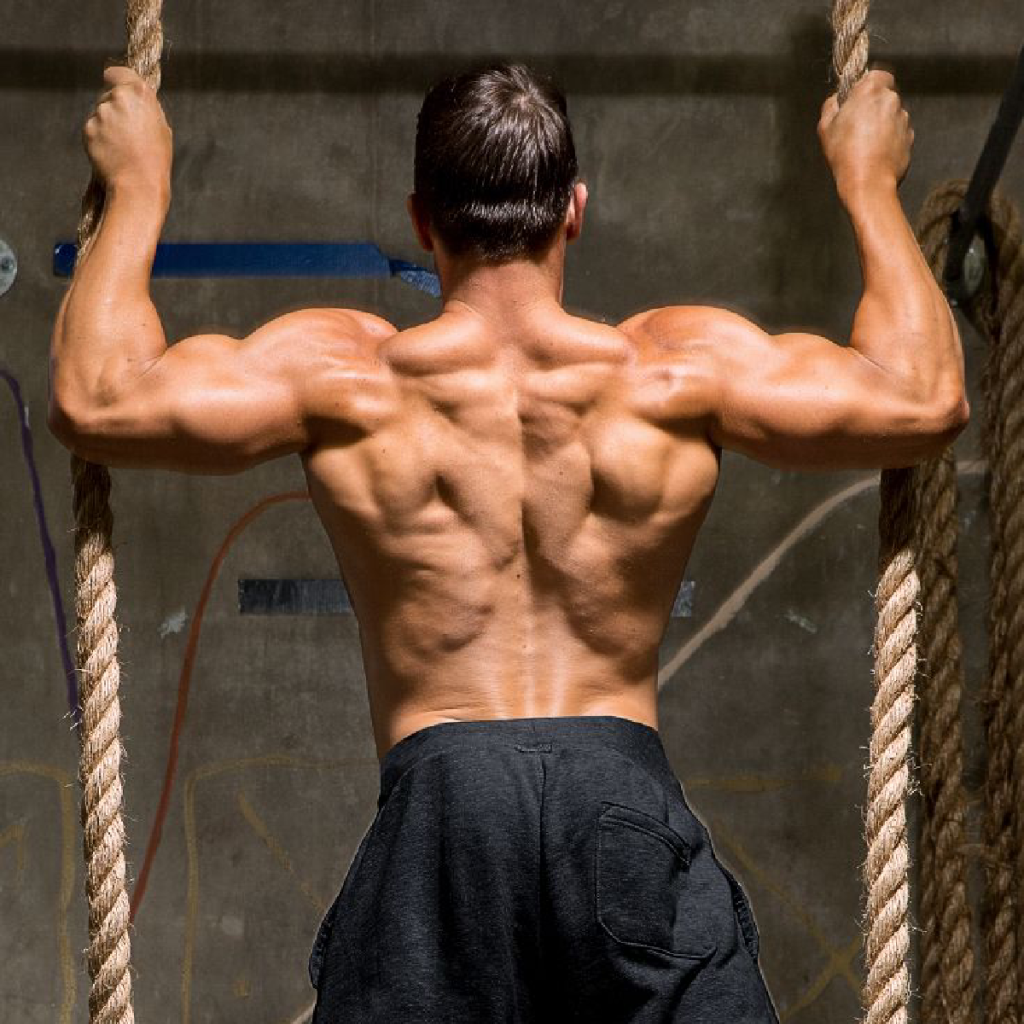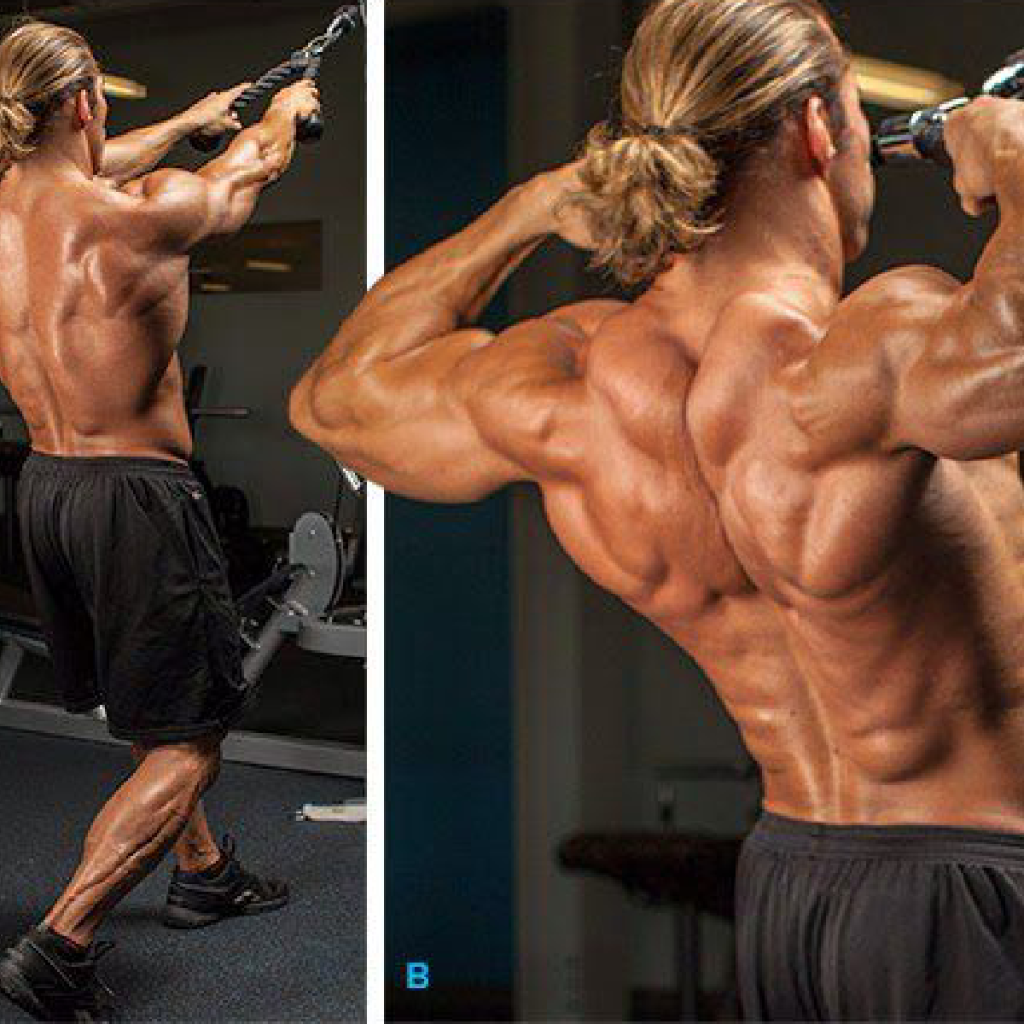Learn how to build back muscles effectively with this comprehensive step-by-step guide.
How to Build Back Muscles: A Step-by-Step Guide
Building strong back muscles is crucial for overall fitness and well-being. Not only do they help you maintain proper posture and mobility, but they also reduce the risk of back pain. In this step-by-step guide, we will explore the anatomy of back muscles, the importance of building them up, the essential equipment needed, nutritional guidelines, and various exercises to get you started on your journey to a strong and sculpted back.

Understanding the Anatomy of Back Muscles
Before diving into the world of back muscle building, it’s important to have a basic understanding of the different muscles that make up your back. The major back muscles include the latissimus dorsi, the trapezius, the rhomboids, and the erector spinae. Each plays a unique role in supporting your body and aiding in movement.
The latissimus dorsi, also known as the “lats,” is the largest muscle in your back. It extends from your upper arm to your lower back and plays a key role in movements like pulling, lifting, and swimming.
The trapezius muscle runs from the back of your neck down to your upper back. It helps stabilize and move your shoulder blades, allowing for proper arm and neck movements.
The rhomboids, located between your shoulder blades, retract and stabilize your shoulder blades, allowing for proper posture and shoulder movement.
The erector spinae muscles, which run along your spine’s length, provide stability and help you maintain an upright posture.
How Back Muscles Support Your Body
Your back muscles are like the superheroes of your body, providing support and stability for your spine and surrounding muscles. They help you maintain good posture, whether you’re sitting, standing, or engaging in physical activities. Strong back muscles also prevent the common issue of back pain, as they support your spine and distribute forces evenly throughout your body.
But what exactly happens when you engage your back muscles? Let’s take a closer look:
When you sit down, your back muscles work together to keep your spine aligned and prevent slouching. The erector spinae muscles play a crucial role in this, as they contract to maintain an upright posture. Additionally, the trapezius muscles help support your neck and shoulders, preventing strain and discomfort.
When you stand up, your back muscles continue to provide support and stability. The latissimus dorsi muscles, being the largest muscles in your back, play a significant role in maintaining an upright position. They help you maintain balance and control as you move your arms and upper body.
During physical activities, your back muscles are put to the test. Whether you’re lifting weights, swimming, or playing sports, the latissimus dorsi muscles are heavily involved. They are responsible for pulling movements, such as rowing or doing pull-ups. The trapezius muscles also come into play during these activities, as they help stabilize your shoulder blades and allow for proper arm movements.
It’s worth mentioning the importance of the rhomboid muscles in maintaining good posture. These muscles, located between your shoulder blades, work to retract and stabilize your shoulder blades. This action helps prevent rounded shoulders and promotes a healthy alignment of your upper body.
Overall, the back muscles are essential for everyday movements and physical activities. They provide the foundation for a strong and stable spine, allowing you to perform tasks with ease and reducing the risk of injuries. So, next time you engage in any activity, remember to give credit to your back muscles for their hard work!
The Importance of Building Strong Back Muscles
Now that you have a basic understanding of back muscles, let’s delve into why building them up is so important.
Building strong back muscles can improve your posture, helping you stand tall and confident. When your back muscles are weak, you may slouch or hunch forward, leading to poor posture and various musculoskeletal issues. By strengthening your back muscles, you promote proper alignment, reducing strain on your spine and enhancing your overall mobility.
But that’s not all! Building strong back muscles also offers a myriad of other benefits that go beyond just posture and mobility.
Benefits for Posture and Mobility
As mentioned earlier, building strong back muscles can significantly improve your posture. But what exactly does good posture entail? Good posture involves the alignment of various body parts, including the head, neck, shoulders, spine, and hips. When these body parts are properly aligned, it not only improves your appearance but also allows your muscles and joints to function optimally.
Additionally, having strong back muscles can enhance your overall mobility. Whether you’re an athlete looking to improve your performance or an individual who wants to move with ease in your daily activities, having a strong back can make a world of difference. Strong back muscles provide stability and support to your spine, allowing you to move more efficiently and with less effort.
Reducing the Risk of Back Pain
Back pain is a common complaint that affects millions of people worldwide. It can range from mild discomfort to debilitating pain, impacting your quality of life and limiting your ability to perform everyday tasks. However, by building strong back muscles, you can significantly reduce the risk of experiencing back pain.
Strong back muscles act as a protective buffer, absorbing shocks and reducing the load on your spine. When your back muscles are weak, the burden of supporting your upper body falls on your spine, leading to increased stress and potential injury. By strengthening these muscles, you create a strong support system for your spine, minimizing the risk of strain and injury.
Furthermore, if you already suffer from back pain, building strong back muscles can help alleviate your symptoms. Strengthening your back muscles can improve the stability of your spine and provide better support, leading to reduced pain and discomfort.
So bid farewell to those nagging backaches and embrace a life with a strong and healthy back!
Essential Equipment for Back Muscle Building
Now that you understand the importance of developing strong back muscles, let’s explore the equipment you’ll need to get started.
Building strong back muscles is crucial for maintaining good posture, preventing back pain, and improving overall strength and stability. Whether you’re a beginner or an experienced lifter, having the right equipment can make a significant difference in your back muscle-building journey.
Free Weights and Barbells
Free weights and barbells are excellent tools for back muscle building. Not only do they provide a greater range of motion compared to machines, but they also engage the major back muscles more effectively. Exercises like bent-over rows, deadlifts, and pull-ups are staples in any back workout routine.
Bent-over rows target the muscles in your upper and middle back, including the rhomboids, trapezius, and latissimus dorsi. By pulling the weight towards your chest while maintaining a flat back, you activate these muscles and promote muscle growth and strength.
Deadlifts, on the other hand, work your entire posterior chain, which includes your lower back, glutes, and hamstrings. This compound exercise not only strengthens your back muscles but also improves your overall power and athleticism.
Pull-ups are a challenging bodyweight exercise that primarily targets your latissimus dorsi, the largest muscle in your back. By pulling your bodyweight up towards the bar, you engage your back muscles and promote muscle growth and definition.
Resistance Bands and Cables
If you prefer a more versatile and portable option, resistance bands and cables are perfect for you. These tools allow for a wide range of exercises that target your back muscles from various angles.
Seated rows using resistance bands or cables are an effective exercise for targeting your middle back muscles. By sitting on a bench with your legs extended and pulling the bands or cables towards your body, you engage your rhomboids, trapezius, and latissimus dorsi, promoting muscle growth and strength.
Lat pulldowns are another great exercise that can be done with resistance bands or cables. This exercise targets your latissimus dorsi and helps to build a wide and defined back. By pulling the bands or cables down towards your chest while keeping your elbows pointed down, you engage your back muscles and promote muscle growth and definition.
One of the advantages of using resistance bands and cables is the constant tension they provide throughout the entire range of motion. This constant tension helps to stimulate muscle growth and improve muscle endurance.
Whether you choose to use free weights and barbells or resistance bands and cables, it’s essential to start with lighter weights or resistance and gradually increase as you build strength and improve your form. Remember to always prioritize proper form and technique to avoid injury and maximize the effectiveness of your workouts.
Nutritional Guidelines for Muscle Growth
Building back muscles goes hand in hand with proper nutrition. Here are some essential guidelines to fuel your muscle growth:
Protein Intake and Muscle Development
Protein is the building block of muscles, so it’s crucial to consume an adequate amount. Aim for approximately 0.8 to 1 gram of protein per pound of body weight per day. Lean sources like chicken, fish, tofu, and beans are excellent choices to meet your protein needs and support muscle development.
Importance of Hydration and Electrolytes
Hydration plays a vital role in muscle function and overall performance. Make sure to drink enough water throughout the day to stay adequately hydrated. Additionally, replenishing electrolytes lost through sweat is essential, especially if you engage in intense workouts. Sports drinks or electrolyte-infused water can help you maintain proper hydration while exercising your back muscles.
Step-by-Step Exercises for Back Muscle Building
Now it’s time to get moving and start building those strong back muscles!

Beginner Level Back Exercises
If you’re new to back muscle building, start with these exercises:
- Bent-Over Rows: Stand with your feet shoulder-width apart, knees slightly bent. Hold a dumbbell in each hand, palms facing your body. Bend forward from the waist while keeping your back straight, then pull the weights up towards your lower chest, squeezing your shoulder blades together. Repeat for the desired number of reps.
- Superman Exercise: Lie face down on the floor with your arms extended in front of you. Raise your arms, legs, and chest off the ground, engaging your back muscles. Hold for a few seconds, then lower down. Repeat for several repetitions.
Intermediate Level Back Exercises
Once you’ve mastered the beginner exercises, challenge yourself with these intermediate exercises:
- Wide-Grip Lat Pulldown: Sit at a lat pulldown machine, taking a wide grip on the bar. Lean back slightly and pull the bar down towards your chest, engaging your back muscles. Slowly release the bar back to the starting position. Repeat for the desired number of reps.
- Seated Cable Rows: Sit at a cable row machine with your legs extended, grabbing the handles with an overhand grip. Keep your back straight as you pull the handles towards your torso, squeezing your shoulder blades together. Slowly release the handles back to the starting position. Repeat for several repetitions.
Advanced Level Back Exercises
If you’ve reached advanced level status, challenge yourself with these advanced back exercises:
- Pull-Ups: Grab a pull-up bar with your palms facing away from you, hands slightly wider than shoulder-width apart. Engage your back muscles and pull your chest towards the bar while keeping your body straight. Lower yourself back to the starting position with control. Repeat for the desired number of reps.
- Barbell Deadlift: Stand with your feet shoulder-width apart, toes pointed slightly outward. Bend down and grip the barbell with an overhand grip just outside your legs. Keep your back straight as you lift the barbell by extending your hips and knees. Lower the barbell back down with control. Repeat for several repetitions.
Building back muscles is an ongoing process that requires consistency and dedication. Start with the exercises that suit your current fitness level and gradually progress as you become stronger. Remember to listen to your body and give yourself adequate rest and recovery time between workouts.
So, what are you waiting for? Get ready to strengthen and sculpt your back with these step-by-step exercises and techniques. With a playful attitude, embrace the challenge and watch as you transform your back into a powerhouse of strength and stability!







